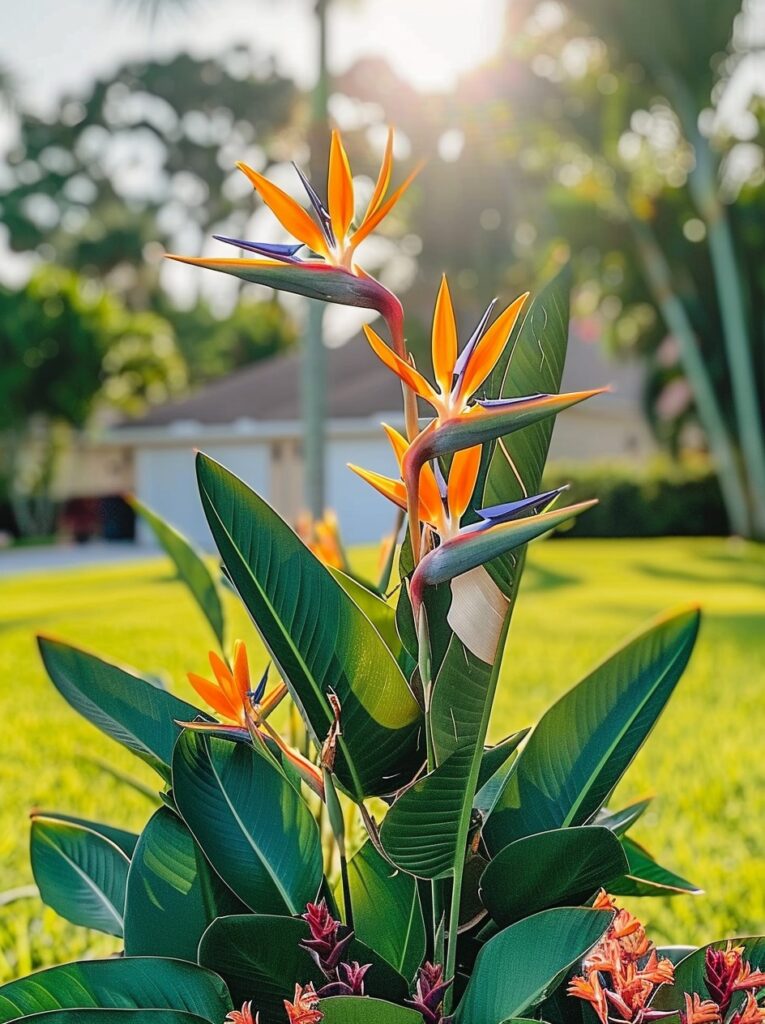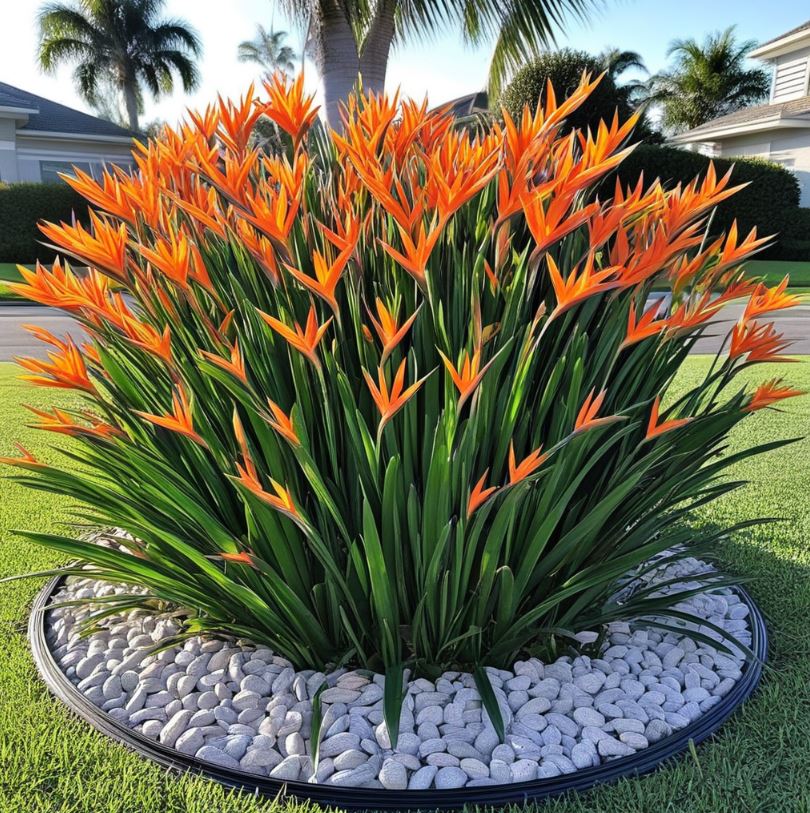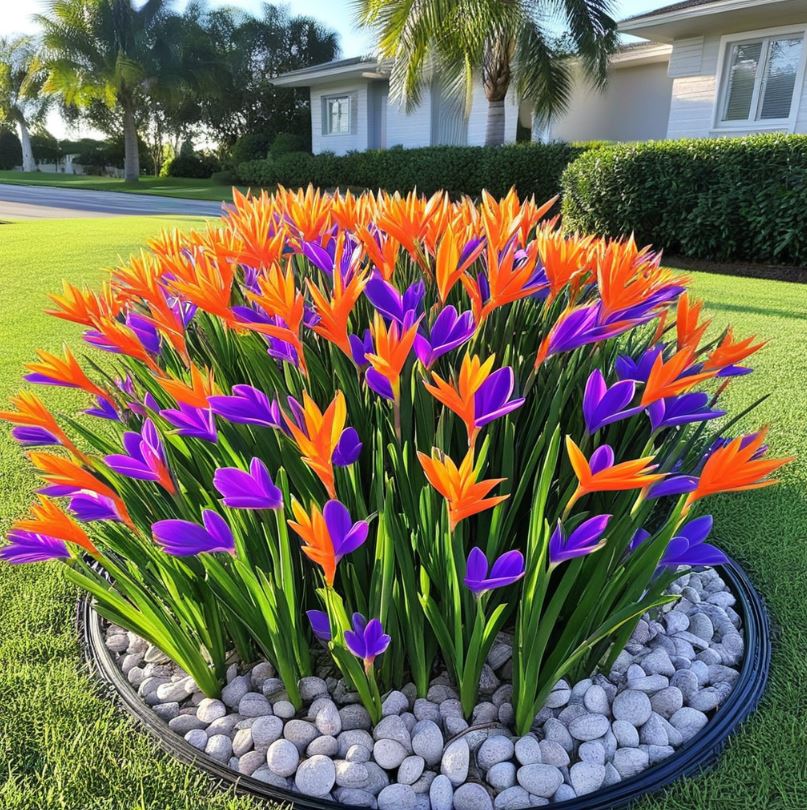Growing the spectacular Bird of Paradise plant (Strelitzia reginae) is not just about planting a seed and watering it; it’s an artistic endeavor that invites you to engage with nature in a symphony of colors, textures, and growth stages. Much like nurturing a budding artist, caring for this iconic tropical beauty requires patience, knowledge, and a keen observational eye.
Light Requirements
The light requirements are pivotal for the thriving health of your Bird of Paradise. Full sunlight will encourage the beautiful, exotic flowers that seem to dance in vibrant shades of orange and blue. Imagine those petals unfurling like a painter’s brush creating bold strokes on a canvas!

Outdoor Lighting
If growing your Bird of Paradise outdoors, it’s crucial to ensure that the plant receives ample sunlight throughout the day. Ideally, the plant should be placed in a location that receives direct sunlight for at least 6 hours per day, with the possibility of partial shade during the hottest afternoon hours.
This balance of sun and shade mimics the plant’s natural environment, where it would thrive in the warm, tropical regions. By providing the right amount of light, you’ll encourage the development of the plant’s signature large, paddle-shaped leaves and the stunning, exotic flowers that seem to defy gravity.
Indoor Lighting
For those growing their Bird of Paradise indoors, placing the plant near a south-facing window where sunlight shines unabated during the day is crucial. This ensures that the plant receives the necessary light to maintain its vibrant colors and promote healthy growth.
If natural light is scarce, you may need to supplement with grow lights. These specialized lighting systems can provide the specific wavelengths and intensity that the Bird of Paradise craves, helping to replicate the conditions it would experience in its natural habitat.

Experiment with different placement and lighting setups to find the perfect balance for your indoor Bird of Paradise. Observe the plant’s growth and behavior, making adjustments as needed to ensure it thrives in its artificial environment.
Watering Techniques
Finding the right balance in watering is crucial; too little could lead to dehydration while too much can drown the roots. Like balancing a delicate melody, consistency is key here.
During the spring and summer growth periods, ensuring the soil remains moist but not waterlogged will promote healthy growth. In fall and winter, reduce watering as the plant goes dormant, mimicking the natural cycles found in a well-composed symphony. Aim for slightly drier conditions during these periods.
Watering Schedule
Establish a consistent watering schedule that aligns with the plant’s growth cycles. During the active growing season, water the Bird of Paradise when the top inch of soil feels dry to the touch. Avoid letting the soil become completely dry, as this can stress the plant and hinder its development.
When watering, pour slowly and deeply, allowing the water to fully saturate the soil. Avoid getting water on the leaves, as this can lead to the development of fungal diseases.
Drainage and Soil Moisture
Ensure that your Bird of Paradise is planted in well-draining soil to prevent the roots from sitting in waterlogged conditions. A mix of sand, peat, and loam can create the perfect medium that not only supports root development but also facilitates drainage.

Monitor the soil moisture closely, and adjust your watering schedule as needed based on environmental factors such as temperature, humidity, and sunlight exposure. The goal is to maintain a consistent level of moisture, neither too dry nor too wet.
Potting and Repotting
If growing your Bird of Paradise in a container, be mindful of the pot size. Opt for a pot that is slightly larger than the root system, as this will allow for growth without becoming waterlogged. Remember to provide adequate drainage holes to ensure excess water can easily escape.
When the plant outgrows its current pot, it’s time to repot. This process should be done in the spring or early summer, when the plant is actively growing. Gently remove the plant from its current pot and carefully transfer it to a new, slightly larger container filled with fresh, well-draining soil.
By mastering the art of watering your Bird of Paradise, you’ll create the perfect environment for this tropical beauty to thrive, much like an artist fine-tuning the details of their masterpiece.
Fertilization Strategy
In terms of fertilization, providing a balanced fertilizer monthly during the active growth period can significantly boost its vibrancy, similar to how an artist enriches their palette with myriad hues. Look for fertilizers high in potassium and phosphorous to support blooming.
Nutrient Requirements
The Bird of Paradise is a heavy feeder, requiring a steady supply of nutrients to sustain its rapid growth and produce those stunning flowers. A balanced fertilizer that contains a blend of nitrogen, phosphorus, and potassium (NPK) is ideal, with a ratio such as 10-10-10 or 12-12-12.
These essential nutrients play crucial roles in the plant’s development. Nitrogen supports the growth of lush, green foliage, phosphorus enhances root and flower production, and potassium strengthens the plant’s overall health and resilience.

Fertilizer Application
Apply the fertilizer monthly during the spring and summer growing seasons, following the instructions on the product label. Avoid fertilizing during the fall and winter months when the plant is dormant, as this can lead to excessive growth and potential damage.
When applying the fertilizer, be mindful of the concentration and distribute it evenly around the root zone. Avoid getting the fertilizer directly on the leaves, as this can cause burning and damage.
Slow-Release Fertilizers
It’s fascinating to note how applying slow-release fertilizer can act like finely tuning the strings of a musical instrument, helping to harmonize the plant’s growth. These specialized formulations gradually release nutrients over an extended period, providing a steady supply of nourishment without overwhelming the plant.
The gradual release of nutrients mimics the natural cycles found in the Bird of Paradise’s native environment, allowing the plant to absorb and utilize the elements as needed. This approach can lead to more consistent, balanced growth, just as an artist meticulously blends colors on their palette.
By incorporating a strategic fertilization plan into your Bird of Paradise care, you’ll be rewarded with a vibrant, thriving plant that showcases its stunning blooms in all their glory.
Pruning Importance
Another vital aspect of caring for the Bird of Paradise is pruning. Just as artists might edit their works to create a masterpiece, pruning older leaves and spent blooms encourages new growth and helps maintain a clean aesthetic. This process can also ensure better air circulation around the plant, reducing the risk of pests or diseases.
Removing Old Leaves
As the Bird of Paradise matures, the older, lower leaves will begin to yellow and die off. It’s essential to remove these leaves promptly to promote the growth of new, healthy foliage. Use clean, sharp scissors or pruning shears to carefully snip the leaves at the base, close to the soil line.
Removing the old leaves not only improves the plant’s appearance but also ensures that the plant’s energy is directed towards new growth rather than maintaining dying or damaged foliage.
Deadheading Spent Flowers
Once the Bird of Paradise has finished blooming, the spent flowers should be removed to encourage the plant to direct its resources towards producing new flowers. Gently snip the flower stalks at the base, just above the nearest leaf.
Deadheading these spent blooms not only keeps your plant looking tidy but also stimulates the development of additional flower spikes, extending the overall flowering period.
Maintaining Shape and Structure
Occasional pruning of the plant’s leaves and stems can also help maintain its overall shape and structure. As the Bird of Paradise matures, it may develop a more leggy or unbalanced appearance. Carefully trimming back any wayward or overgrown foliage can help restore the plant’s natural, symmetrical form.
Be mindful not to over-prune, as this can stress the plant and inhibit its growth. Instead, make strategic cuts to remove any damaged, diseased, or misshapen parts, leaving the healthy portions intact.
By incorporating regular pruning into your Bird of Paradise care routine, you’ll not only keep your plant looking its best but also encourage robust, vibrant growth, much like an artist refining their masterpiece.
Pests and Diseases Management
Managing potential pests and diseases should also be part of your overall strategy. Common culprits such as aphids or spider mites can threaten your plant’s health. Regularly inspecting the leaves for signs of unwelcome visitors ensures you catch issues early, much like an artist critiquing their work for flaws before it’s presented to the world.
Identifying and Addressing Pests
Keep a close eye on your Bird of Paradise for any signs of pest infestations, such as small insects, webbing, or discolored or distorted leaves. Aphids, spider mites, and scale insects are among the most common pests that can afflict these plants.
If you spot any unwanted guests, act quickly to remove them. You can try physical methods, such as wiping down the leaves with a damp cloth or using a strong stream of water to dislodge the pests. For more severe infestations, consider using a gentle, eco-friendly insecticidal soap or neem oil spray to effectively eliminate the pests without harming the plant.
Preventing and Treating Diseases
In addition to pests, the Bird of Paradise can also be susceptible to certain diseases, such as fungal infections or bacterial rot. Maintain good air circulation around the plant, avoid getting water on the leaves, and ensure the soil is well-draining to minimize the risk of disease.
If you notice any signs of disease, such as discolored, wilting, or mushy leaves, act quickly to address the issue. Prune away any affected parts of the plant and consider using a fungicide or bactericide, following the product instructions carefully.
Monitoring and Preventive Care
Regular inspections and proactive care are key to keeping your Bird of Paradise healthy and thriving. Closely monitor the plant for any changes or signs of distress, and address any issues promptly before they escalate.
Maintaining good hygiene, such as cleaning your pruning tools and disinfecting the plant’s environment, can also help prevent the spread of pests and diseases. By staying vigilant and taking a preventive approach, you can ensure your Bird of Paradise continues to captivate with its magnificent blooms.
Conclusion
In essence, cultivating a Bird of Paradise is a multidimensional experience, requiring not just gardening knowledge but artistic flair, enabling one to bring a touch of tropical luxury into any living space. As you witness your efforts blossom into stunning floral displays reminiscent of exotic birds taking flight, you realize that each step—be it selecting the right pot, monitoring sunlight, or maintaining soil moisture—is akin to carefully composing a masterful piece of art; it’s all about fostering life’s dynamic beauty in your very own green gallery.
Unleashing the magical allure of the Bird of Paradise can become more than cultivation; it transforms into an emotional journey—a vivid reminder of nature’s artistry at play. By embracing the challenges and nuances of growing this spectacular plant, you’ll not only cultivate a stunning focal point in your living space but also nurture a deeper connection with the natural world, much like an artist who pours their soul into every brushstroke.




